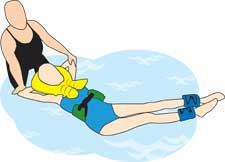ADDITIONAL RESOURCES
Here are more ways to find out how you can bring Bad Ragaz to your facility.
www.aquaticnet.com/ai.htm
An online clearinghouse of aquatic therapy information for Aquatics International readers. It includes the latest research on Ai Chi, Bad Ragaz, Watsu and other aquatics techniques.
www.multimediasupport.nl/badragaz
Excellent online interactive CD that demonstrates the Bad Ragaz Ring Method patterns in photo and video format.
www.halliwick.net
Home page of the Bad Ragaz Ring Method Foundation (located in The Netherlands).
Imagine a woman with severe kyphosis (excessive outward curvature of the spine) who enters a physical therapy clinic. In what position should the therapist place her to be able to work on her complaints?
Position her on her back, and you’ve lost access to the very part you wish to address. Place her on her side, and you create an awkward position for access and for treatment. Roll her to her belly — and watch in wonder as nothing but forehead and knees touch! Put her in a chair and you have reintroduced gravity into the mix.
However, all these concerns disappear in your pool: The water itself can become the treatment table. The woman can be positioned comfortably on her back — and yet the therapist retains access to flex, extend, side-bend, and rotate the spine.
This concept of a floating plinth was first popularized in the 1950s by German physicians Knupfer and Tom Suden. These men first developed strengthening exercises in which a patient could be supported by rings or floats around the neck, arms, pelvis and knees while lying horizontally in the water.
By the 1960s, these original exercises were altered into more three-dimensional and functional patterns by Margaret Knott, Beatrice Egger and James McMillan. The modified technique was renamed the “New Bad Ragaz Method with Rings.” (For an illustration of the Bad Ragaz Trunk Pattern, click here.)
To provide the Ring Method, you will need an unobstructed area in your pool no smaller than 8 feet by 8 feet for each therapist-client pair.
In the Bad Ragaz Ring Method, the patient lies horizontally on the pool’s surface while the therapist stands as a fixed point of contact. If the water depth is too deep, the therapist cannot provide a fixed point and will be “pushed about” in the water,
reducing the workload for the client. If the water depth is too shallow, the therapist won’t be able to find natural and comfortable hand-holds on the patient.
Most therapists tend to stand in waist-deep water (around the T11-T12 vertebral level), though deeper water can be used if the therapist can make use of a wall to stabilize himself. Pools with a sloping bottom that runs between 3 feet to 4 feet deep will work just fine.
Most therapy pools hold their temperatures between 90 and 94 degrees Fahrenheit. But because the Ring Method is a vigorous workout for therapist and client, cooler pools (85 to 90 degrees Fahrenheit) are not verboten.
At a minimum, your facility will need to purchase cervical flotation collars (either air, foam or pellet-filled), waist or hip flotation belts, and several extremity floats to offer this technique.
It is difficult to learn the Ring Method from a book or even from an interactive video. Numerous Bad Ragaz Ring Method courses are taught throughout the United States and in Europe, so that practitioners can master the intricate handling skills needed prior to using these skills with patients.



